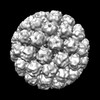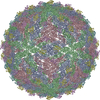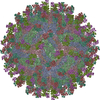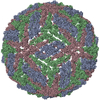[English] 日本語
 Yorodumi
Yorodumi- EMDB-5181: The structure of avian polyomavirus (empty capsids) treated with ... -
+ Open data
Open data
- Basic information
Basic information
| Entry | Database: EMDB / ID: EMD-5181 | |||||||||
|---|---|---|---|---|---|---|---|---|---|---|
| Title | The structure of avian polyomavirus (empty capsids) treated with 250 mM L-arginine | |||||||||
 Map data Map data | Cryo-EM based reconstruction of avian polyomavirus empty capsids | |||||||||
 Sample Sample |
| |||||||||
 Keywords Keywords | avian /  polyomavirus / VP4 polyomavirus / VP4 | |||||||||
| Biological species |  avian polyomavirus avian polyomavirus | |||||||||
| Method |  single particle reconstruction / single particle reconstruction /  cryo EM / cryo EM /  negative staining / Resolution: 17.3 Å negative staining / Resolution: 17.3 Å | |||||||||
 Authors Authors | Shen PS / Enderlein D / Nelson C / Carter WS / Kawano M / Xing L / Swenson RD / Olson NH / Baker TS / Cheng RH ...Shen PS / Enderlein D / Nelson C / Carter WS / Kawano M / Xing L / Swenson RD / Olson NH / Baker TS / Cheng RH / Atwood WJ / Johne R / Belnap DM | |||||||||
 Citation Citation |  Journal: Virology / Year: 2011 Journal: Virology / Year: 2011Title: The structure of avian polyomavirus reveals variably sized capsids, non-conserved inter-capsomere interactions, and a possible location of the minor capsid protein VP4. Authors: Peter S Shen / Dirk Enderlein / Christian D S Nelson / Weston S Carter / Masaaki Kawano / Li Xing / Robert D Swenson / Norman H Olson / Timothy S Baker / R Holland Cheng / Walter J Atwood / ...Authors: Peter S Shen / Dirk Enderlein / Christian D S Nelson / Weston S Carter / Masaaki Kawano / Li Xing / Robert D Swenson / Norman H Olson / Timothy S Baker / R Holland Cheng / Walter J Atwood / Reimar Johne / David M Belnap /  Abstract: Avian polyomavirus (APV) causes a fatal, multi-organ disease among several bird species. Using cryogenic electron microscopy and other biochemical techniques, we investigated the structure of APV and ...Avian polyomavirus (APV) causes a fatal, multi-organ disease among several bird species. Using cryogenic electron microscopy and other biochemical techniques, we investigated the structure of APV and compared it to that of mammalian polyomaviruses, particularly JC polyomavirus and simian virus 40. The structure of the pentameric major capsid protein (VP1) is mostly conserved; however, APV VP1 has a unique, truncated C-terminus that eliminates an intercapsomere-connecting β-hairpin observed in other polyomaviruses. We postulate that the terminal β-hairpin locks other polyomavirus capsids in a stable conformation and that absence of the hairpin leads to the observed capsid size variation in APV. Plug-like density features were observed at the base of the VP1 pentamers, consistent with the known location of minor capsid proteins VP2 and VP3. However, the plug density is more prominent in APV and may include VP4, a minor capsid protein unique to bird polyomaviruses. | |||||||||
| History |
|
- Structure visualization
Structure visualization
| Movie |
 Movie viewer Movie viewer |
|---|---|
| Structure viewer | EM map:  SurfView SurfView Molmil Molmil Jmol/JSmol Jmol/JSmol |
| Supplemental images |
- Downloads & links
Downloads & links
-EMDB archive
| Map data |  emd_5181.map.gz emd_5181.map.gz | 92.5 MB |  EMDB map data format EMDB map data format | |
|---|---|---|---|---|
| Header (meta data) |  emd-5181-v30.xml emd-5181-v30.xml emd-5181.xml emd-5181.xml | 10.8 KB 10.8 KB | Display Display |  EMDB header EMDB header |
| Images |  emd_5181_1.jpg emd_5181_1.jpg | 42.2 KB | ||
| Archive directory |  http://ftp.pdbj.org/pub/emdb/structures/EMD-5181 http://ftp.pdbj.org/pub/emdb/structures/EMD-5181 ftp://ftp.pdbj.org/pub/emdb/structures/EMD-5181 ftp://ftp.pdbj.org/pub/emdb/structures/EMD-5181 | HTTPS FTP |
-Related structure data
| Related structure data |  5180C  5182C  5183C  5184C  5187C  3iysC C: citing same article ( |
|---|---|
| Similar structure data |
- Links
Links
| EMDB pages |  EMDB (EBI/PDBe) / EMDB (EBI/PDBe) /  EMDataResource EMDataResource |
|---|
- Map
Map
| File |  Download / File: emd_5181.map.gz / Format: CCP4 / Size: 184.1 MB / Type: IMAGE STORED AS FLOATING POINT NUMBER (4 BYTES) Download / File: emd_5181.map.gz / Format: CCP4 / Size: 184.1 MB / Type: IMAGE STORED AS FLOATING POINT NUMBER (4 BYTES) | ||||||||||||||||||||||||||||||||||||||||||||||||||||||||||||||||||||
|---|---|---|---|---|---|---|---|---|---|---|---|---|---|---|---|---|---|---|---|---|---|---|---|---|---|---|---|---|---|---|---|---|---|---|---|---|---|---|---|---|---|---|---|---|---|---|---|---|---|---|---|---|---|---|---|---|---|---|---|---|---|---|---|---|---|---|---|---|---|
| Annotation | Cryo-EM based reconstruction of avian polyomavirus empty capsids | ||||||||||||||||||||||||||||||||||||||||||||||||||||||||||||||||||||
| Voxel size | X=Y=Z: 1.57 Å | ||||||||||||||||||||||||||||||||||||||||||||||||||||||||||||||||||||
| Density |
| ||||||||||||||||||||||||||||||||||||||||||||||||||||||||||||||||||||
| Symmetry | Space group: 1 | ||||||||||||||||||||||||||||||||||||||||||||||||||||||||||||||||||||
| Details | EMDB XML:
CCP4 map header:
| ||||||||||||||||||||||||||||||||||||||||||||||||||||||||||||||||||||
-Supplemental data
- Sample components
Sample components
-Entire : avian polyomavirus with 250 mM L-arginine
| Entire | Name: avian polyomavirus with 250 mM L-arginine |
|---|---|
| Components |
|
-Supramolecule #1000: avian polyomavirus with 250 mM L-arginine
| Supramolecule | Name: avian polyomavirus with 250 mM L-arginine / type: sample / ID: 1000 / Oligomeric state: virions / Number unique components: 1 |
|---|
-Supramolecule #1: avian polyomavirus
| Supramolecule | Name: avian polyomavirus / type: virus / ID: 1 / Name.synonym: avian polyomavirus Details: Cryo-EM of avian polyomavirus over holey carbon grids Sci species name: avian polyomavirus / Database: NCBI / Virus type: VIRION / Virus isolate: STRAIN / Virus enveloped: No / Virus empty: Yes / Syn species name: avian polyomavirus |
|---|---|
| Host (natural) | synonym: VERTEBRATES |
| Virus shell | Shell ID: 1 / Name: VP1 / Diameter: 5000 Å / T number (triangulation number): 7 |
-Experimental details
-Structure determination
| Method |  negative staining, negative staining,  cryo EM cryo EM |
|---|---|
 Processing Processing |  single particle reconstruction single particle reconstruction |
| Aggregation state | particle |
- Sample preparation
Sample preparation
| Buffer | pH: 10.7 Details: 200 mM NaCl, 20 mM Tris-HCl, 1 mM CaCl2 buffer, 250 mM L-arginine, pH 10.7 |
|---|---|
| Staining | Type: NEGATIVE / Details: no stain (cryo-EM) |
| Grid | Details: 200 mesh copper grid (holey carbon) |
| Vitrification | Cryogen name: ETHANE / Chamber humidity: 100 % / Chamber temperature: 89 K / Instrument: OTHER Details: Vitrification instrument: Vitrobot. vitrification carried out in nitrogen atmosphere Method: 1 second blot before plunging |
- Electron microscopy
Electron microscopy
| Microscope | FEI TECNAI F30 |
|---|---|
| Electron beam | Acceleration voltage: 200 kV / Electron source:  FIELD EMISSION GUN FIELD EMISSION GUN |
| Electron optics | Calibrated magnification: 39000 / Illumination mode: FLOOD BEAM / Imaging mode: BRIGHT FIELD Bright-field microscopy / Cs: 2 mm / Nominal defocus max: 4.9 µm / Nominal defocus min: 0.5 µm / Nominal magnification: 39000 Bright-field microscopy / Cs: 2 mm / Nominal defocus max: 4.9 µm / Nominal defocus min: 0.5 µm / Nominal magnification: 39000 |
| Sample stage | Specimen holder: Side entry liquid nitrogen-cooled cryo specimen holder Specimen holder model: GATAN LIQUID NITROGEN |
| Temperature | Min: 88 K / Max: 95 K / Average: 90 K |
| Alignment procedure | Legacy - Astigmatism: astigmatism was corrected at 59,000 times magnification |
| Date | Apr 23, 2007 |
| Image recording | Category: FILM / Film or detector model: KODAK SO-163 FILM / Digitization - Scanner: NIKON SUPER COOLSCAN 9000 / Digitization - Sampling interval: 1.57 µm / Number real images: 88 / Details: Micrographs digitized in positive contrast mode. / Bits/pixel: 16 |
| Experimental equipment |  Model: Tecnai F30 / Image courtesy: FEI Company |
- Image processing
Image processing
| CTF correction | Details: each micrograph |
|---|---|
| Final reconstruction | Algorithm: OTHER / Resolution.type: BY AUTHOR / Resolution: 17.3 Å / Resolution method: FSC 0.33 CUT-OFF / Software - Name: PFT2 and EM3DR2 |
 Movie
Movie Controller
Controller













